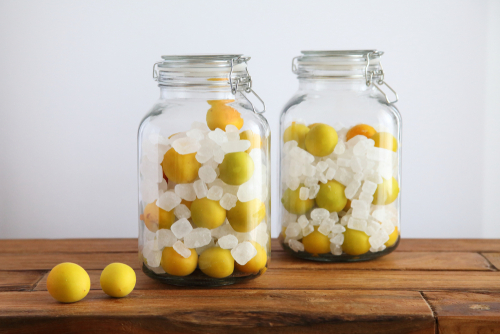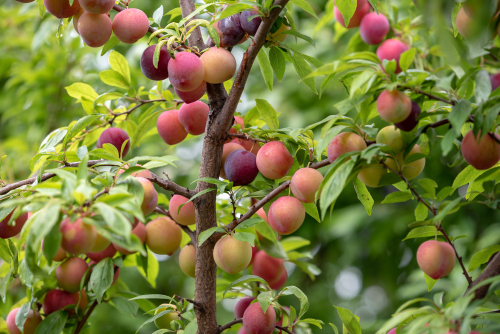Wondering if you can eat Japanese plums? Find out the answer to are Japanese plums edible in this guide that lays down everything you need to know about Japanese plums.
It’s not surprising that people often ask are Japanese plums are edible.
There are so many varieties of Japanese plums and they’re often seen as teeny fruits that grow on trees for the birds to eat. There are also flying tidbits about them being harmful. But not all of it is true.
Keep reading to know about these Japanese plums.
Page Contents
Are Japanese Plums Edible?

Japanese plums in fact are edible. You just have to find the one that suits your taste buds, is available in your region and be mindful of the taste, in case you find some bitter ones. Japanese plums are used to make jams, flavor alcohol or pickle. Infact, Japanese plums (umeboshi) are known to aid in bacterial infections, diarrhoea, nausea, and other problems.
Before we get to the answer of this question, I first have to tell you about the different types of Japanese Plums
First of all, there are so many varieties that are often confused with each other. There are the prunus mume, the prunus salicina and the loquat (Eriobotrya japonica).
Second, because of the fact, that we’ll discover later, that they’re often seen as fruits used for ornamentation, they are often disregarded as something edible.
What are the edible parts of a Japanese Plum?
Well, the fruit itself can be eaten raw or cooked. Once it appears on the tree, it ripens really quickly. Although it can resist rotting fairly well. Some people also eat the seed part of the fruit, although it is recommended that you avoid that if it is bitter (more on that below).
Are Japanese Plums poisonous?
The Japanese plum, that is prunus salicina, has tendencies to produce hydrogen cyanide. This is the element that brings out the distinctive flavours that almonds have. One of the best waist to find out if a leaf or a seed has this is to check if they have an obvious bitter taste.
Usually, the leaves and the seeds have this component in too small a quantity to actually cause any harm, but at the teeniest taste, if it seems overly bitter, don’t consume it.
In fact, research-led studies made scientists believe that consumption of hydrogen cyanide actually stimulates respiration and helps the improvement of digestion, also acts as an aid in the treatment of cancer.

However, if consumed a lot, it actually has a negative imbalance in the same regards and might even cause death.
Related: 4 Rules of Eating Healthy in Japan
Types of Japanese Ume Plums
The Eriobotrya japonica, in other words, the loquat is the most commonly found one and possibly the one that is gaining popularity most rapidly.
These luscious loquats belong to the Rosaceae family, a family that includes peach, pear, apple and nectarine. So you can imagine how juicy and yum this Japanese plum must be.

How people eat it goes right from people picking it straight off the tree to people not even knowing it exists as an edible fruit, let alone use it in a recipe as an ingredient that involves the loquat.
Some people prefer to eat it with the peel and some without. The loquat is just like an apple or a peach, all depends on personal preference and ideal mouth feel.
The loquat is often mistaken as an only-ornamental fruit because of its pretty dusky yellow colour and the fact the loquat leaves are often used in flower arrangements.
How could one not? The underside of the leaves has a silvery glow that ties the whole thing up together.
Next, is prunus mume. While one of its common names is being called the Japanese plum, in my opinion, its characteristics resemble more of an apricot. The tree they grow on is commonly known as a Plum Blossom.
In fact, some people confuse the tree with Japan’s coveted cherry blossoms that go in full bloom. One way to tell the difference is by looking at the petals of the flowers.
While cherry blossoms have split ends at the end of each petal, the plum blossoms don’t.
Related: Why Are Japanese Fruits SO Expensive?
This unique three has roots that lead to both the plum and apricot families, therefore, it has characteristics of both. The fruit itself is used in a variety of food items, or to create some — people use it to flavour unique kinds of alcohol, make pickles and also some forms of medicine.
Third, comes the prunus salicina. In my opinion, this one is the one that resembles a plum the most, in terms of conventional-looking plums and even taste-wise.
There is not enough I can say about this juicy fruit. Since this is the most plum-like of Japanese plums, and more commonly found, the details you’ll find further on in the article. Loquats also steal the show with their sunsets like appearance and peachy and citrusy taste.
Related: Are Japanese Spider crabs Edible?
How To Eat Japanese Ume Plums?
Now that you know how relishing these Japanese plums sound, you’d like to know what are soem of the forms you can actually eat them in. These Japanese plums are so versatile. You can make something from sweet to savoury, main course to dessert. It’s an ingredient that surprisingly goes well with a lot of things.
But be careful of the kind of Japanese plum you are getting for yourself. Remember the code: loquats are orange-yellow, prunus mume/ume are apricot-like and prunus salicina are look-alikes of conventional plums.
The loquats have high pectin and sugar content, making them a go-to if you’re looking for a natural sweetener. People eat them in a fresh fruit form, but they also are added to perfect fruit salads and fresh fruit comes, it also goes well in a parfait.
The fruit is used to make some juicy jam, jelly, and even forms of chutney or condiments. They can be poached to be served as a sweet syrup to go with pancakes as well. And guess what, if your loquat is firm enough, slice them right up and put them in your pie!
There usually isn’t any wastage, but because the seed is huge, it may seem like 1/3rd of the fruit goes to waste. For confectionery purposes, the fruit is also available in canned form.
In some countries, like Ecuador, people use loquats to make smoothies or the way they like to call it, ‘batidos’. These juice/smoothies are made with loquats and milk, with added ice. To make it more tropical, people often add other fruits as well.
Ume, on the other hand, has high acidity levels. They are rich in antioxidants and have properties of apricots, blueberries, cranberries, plums, and other citrus fruits. It is often used to make a rich sauce, or a fancy jam, even a marmalade. These sauces go well with dark meat and pork chops.
- Related: Why Japanese Eat Raw Fish
- Related: All About Kaki Japanese Persimmon: The Miracle Fruit
- Related: Why Japanese Melons Are Expensive
- Related: Are Japanese peanuts good for you
Can you grow a Japanese Plum tree?
I won’t be surprised if your reaction to reading all this about Japanese plums is to grow a tree yourself. I have fortunate and unfortunate news for you. You’ll be excited to know that you can grow a Japanese plum tree in your backyard, as long as the sun shines brightly for at least 6-8 hours every day.
The unfortunate news being it takes a long long time to grow. It can take up to 18 months simply for the seed to germinate. Maybe a year after that for the flowering to begin. You have to be in it for the long haul. The best thing to do is to purchase a grafted seedling, so you can see the first fruit in the next three years.
But when you do wait long enough, for a spring filled with an abundant supply of Japanese plums, you have a 25 feet tall and 20 feet wide tree of yummy fruitfulness (pun intended). The fruit on these trees usually grow in a cluster of 15 to 20, and form a ripe bunch!
The tree can be slightly high maintenance considering it requires nutrient-rich soil with a pH of around 5.6-6.5. A fully grown tree can be as tall as 30 feet with a wide spread, so make sure you have that kind of space.
Fun fact: Not only are Japanese plum fruits edible, but some countries in Europe also use them to make perfume. Because the yield there is low, it is often considered exotic and unreachably alluring.
Medicinal use of Japanese Ume plum
Nonetheless, the actual fruit part of it works wonders. It does two of the best things — allays thirst and helps battle arthritis.
The species doesn’t specifically mention this, but the entire gene has a presence of amygdalin and prunasin that breaks down when in water to form what is called hydrocyanic acid. In small quantities, this can help achieve a general sense of well-being and also helps with digestion.
In fact, in traditional Chinese medicine, Loquat is used as treatment against cough with phlegm for many years. Since the Loquat is high in antioxidant beta carotene and Vitamin A, it is also known to lower the risk of lung cancer.
In other news, powdered loquat leaves are also useful. They are said to have healing effects in the treatment of diarrhoea, reversing effects of alcohol intoxication and finally, even depression.
Japanese Ume Plums: FAQs
What is a Japanese Ume plum called?
The Japanese plum is called umeboshi, and it is a type of Prunus mume. Umeboshi are sour and salty, and they are usually eaten as a pickled plum. They have a long history of use in traditional Japanese medicine, and they are considered to be one of the most effective remedies for nausea and indigestion.
Why is there confusion about whether or not Japanese plums are edible?
As you may have figured out by now, the many types and the tiny nuances make it impossible to put a finger on which one exactly is a Japanese plum. While defining and labeling a fruit is an often objective subject, when it comes to Japanese plums, people have opinions based on preferences, flavour profiles and the (type of) Japanese plum available in their area.
Are Japanese plums the same as loquat?
While you can certainly eat Japanese plums raw, it is important to note that they are quite tart, astringent and may not be to everyone’s liking. If you do decide to eat them raw, it is best to do so in small quantities at first to see how your taste buds (and stomach) react. Japanese plums can also be used in a variety of recipes, both sweet and savory, so if you’re not a fan of the raw fruit, there are still plenty of ways to enjoy them.
In terms of nutrition, Japanese plums are an excellent source of Vitamin C, potassium, and dietary fiber. They also contain unique compounds like neochlorogenic acid and chlorogenic acid, which have antioxidant and anti-inflammatory properties
Are Japanese plums good to eat?
Japanese plums, also called umeboshi, are highly nutritious and alkalizing. They are a good source of fiber, minerals (including potassium, magnesium, and calcium), and vitamins (especially vitamin C).
Umeboshi have a variety of health benefits. For example, they are known for their detoxifying and alkalizing effects on the body. They are also said to help with digestion, relieve nausea and morning sickness during pregnancy, and act as a natural anti-inflammatory.





